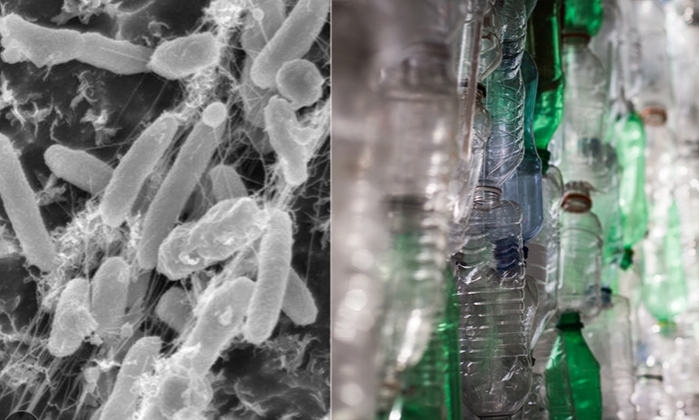 A new hope for better environment in the future, bacterium that eats plastic. (Image via: ZME Science)
A new hope for better environment in the future, bacterium that eats plastic. (Image via: ZME Science)
Hope for Humanity from Japan: Discovery of Plastics-Eating Bacteria
Plastic pollution is one of the challenges the world is currently facing, amid the rise of global warming issue. Plastic, despite integral to human life, is not eco-friendly, since it takes 10-1000 years to decompose, while plastic bottles need 450 or even more years to decompose.When all hope seems lost, a glimmer of hope rises from a plastic bottle processing plant in Sakai, Osaka Prefecture. In 2005, the researcher found bacterium which feeds on plastic polyethylene terephthalate (PET) bottles. Kohei Oda and his colleagues named the bacterium Idionella sakaiensis because it was found in Sakai. The bacterium sparks a seem-to-be-dim, but bright light for humanity in the midst of fight against plastic pollution.
“I hope the bacterium will be a beacon to solve plastic pollution,” said Oda humbly.
When Oda’s research was published in world-scale, the scientific community was baffled. At first, the scientists once pointed out that PET is non-biodegradable, since it is one of the components found in petroleum. Nonetheless, with this findings, they were more than curious to know.
The bacterium and its usage will pave its way to global fame once it is brought to light in the upcoming G-20 Summit in Osaka on 28-29 June.
How exactly does the bacterium works? The bacterium digests PET in plastics products using 2 kinds of enzymes. It was found to consume the PET with thickness of 0.2 mm for a month before decomposing it into carbon dioxide and water, tabulated Shosuke Yoshida, appointed associate professor of environmental microbiology at the Nara Institute of Science and Technology.
The enzymes popped a global race to determine what kind of enzyme it was. Chinese scientists were the one to find out the name of the enzymes and their structures, naming it PETase. Further structures of the enzymes were later delineated by South Korean and Chilean researchers.
Further development was recorded as British scientist found way to efficiently use the enzyme, leading the revolution in plastic industry and reuse of plastic.
In 2019, German researcher succeeded in analyzing the 2nd enzymes through 3-D analysis, naming it MHETase.
Up until now, Yoshida and other scientists are working hand in hand to find the condition that enhance the performance of the enzymes. While the world is praying that the enzyme will finally bring back the green earth once destroyed.
Source: http://www.asahi.com/ajw/articles/AJ201906210037.html
 English
English Japan
Japan

drugs recently approved by fda mandated medicaid coverage of viagra womens viagra pfizer viagra 100mg for sale sildenafil 20 mg tablet coupon
amoxicillin other names azithromycin amoxicillin infant amoxicillin amoxicillin capsules
amoxil complications generic name of amoxil does amoxil make you sleepy amoxil 250 mg suspension pediatrica
neurontin tolerance where can you get gabapentin neurontin and restless leg syndrome how does gabapentin make you feel
free samples for medical offices price of viagra in mexico brand viagra sildenafil citrate 100mg generic rx west discount card online prescription writing doctors usa side effects of viagra 100 mg cost of viagra per pill women's libido booster buy vigora 50 online viagra in india bear weight or bare weight top rx online vitamins for sexual benefits for men drug prices without insurance viagra wirkung sildenafil for hypertension sildenafil with food viagra para mujeres viagra 100mg tablets retail price sildenafil pfizer 50 mg price how to take viagra 100mg viagra kopen viagra prices at walmart pharmacy whats viagra do ejaculation problems with tamsulosin mixing alcohol and ativan visual viagra pfizer patient assistance application form how to decrease libido in women pc generic phone number walmart viagra fda newly approved drugs
prednisone and xanax over the counter prednisone cream can you take prednisone and benadryl how long does it take prednisone to leave your system
prednisone prescription prednisone 20 mg 3 tablets daily what is the medicine prednisone
neurontin lawsuits neurontin 300 mg used for how does gabapentin work in the brain
neurontin 900 mg long term side effects neurontin what is gabapentin use for
zithromax chlymidia zithromax 750 mg how much does azithromycin cost without insurance azithromycin treats what
neurontin user reviews gabapentin cheapest price is neurontin the same as gabapentin how long is gabapentin good for
grease pink ladies makeup side effects cialis 5 mg prescription drugs without doctor approval viagra generic herb viagra green pill how long does viagra effect last natural libido enhancer female
lasix kidney failure lasix 20 mg price in india furosemide and lisinopril on potassium how long after lasix surgery before vision clears
plaquenil contraindications buy plaquenil in india what kind of drug is plaquenil what is plaquenil toxicity?
priligy information priligy buy online india dapoxetine side effects in hindi what is dapoxetine hydrochloride
cialis what to expect teva viagra price viagra tablet ed treatments that really work best price for viagra 100mg
amoxicillin strep purchase amoxil 500mg online amoxil make your head sore can amoxil leave taste in mouth
albuterol generic name ventolin price in india ventolin inhaler how long does it last what albuterol used for
ventorlin vs ventolin combivent respimat package insert how much is too much albuterol ventolin how to take
prednisone psychosis 120 prednisone prednisone dosage for allergic reactions how long does it take for prednisone to work on back pain